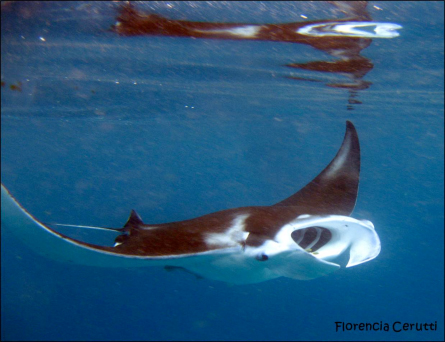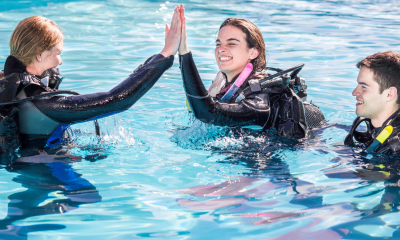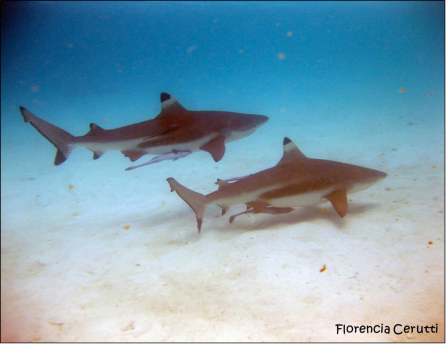Marine Life & Conservation
Indonesia’s First Shark Sanctuary

Shark and Ray conservation is high on the agenda of many scientists and is a subject written about by even more conservationists. I am getting quite a few shark conservation blogs coming through now as more people are driven to write and share their experiences and feelings. All I can say is keep them coming. It shows we care.
We are finally getting into an era where people who are not directly involved with environmental or biological sciences are getting more conscious about our planet’s endangered natural sources. However, the knowledge that actually manages to get to our societies is limited and seems to be very focused on a couple of global ‘fashion’ issues like climate change, saving the dolphins, or transgenic corn. Nothing against that, but there are so many scientific studies, so many other important topics, and so little that passes to our society that it almost seems like a waste. This narrowed-down flow of information also creates a phenomenon that is sort of known as ‘the science/society gap’ where much needed information gets lost. So now I’m writing about the science I’m involved with, not reinventing the wheel here, but instead aiming to ‘fill in some of the gap’ on the topics I love and study: marine conservation and sharks-&-rays .
Now, one of the biggest recent news for sharks & rays is the declaration of a shark sanctuary in Raja Ampat, West Papua, Indonesia (http://blog.conservation.org/2013/02/raja-ampat-launches-indonesias-first-shark-sanctuary/). This is the first shark sanctuary in Indonesia and is a major achievement of the local Papuan communities, Indonesia’s government, and NGOs (Non-government organizations) working in this area. But to understand what the problem is with sharks & rays and why this sanctuary is such an achievement, I will start by explaining what the problem is.
Black tip sharks are now protected in the Shark Sanctuary.
Besides being amazing creatures, sharks & rays are predators and have a very important role in keeping a balanced and healthy marine ecosystem. On the other hand, their populations support intensive fisheries and, therefore, human livelihoods all over the world. Sharks & rays occur in every ocean and in every ocean they are fished: from Mexico to Chile, from Japan to Australia, from UK to Cairo, from India to South Africa; everywhere. Generally, the meat is locally consumed, but the biggest trade and threat is their fins and/or gills which get exported to China to be used in traditional medicine and in traditional soup. Problem is, these animals grow very slow, they take a long time to be mature enough to reproduce, they have low numbers of pups, and they reproduce nowhere near as often as other fish that support similar intensity of fishery like tuna; their life characteristics are more similar of that of a whale or an elephant than that of a tuna or a sardine. The consequence of this is that sharks & rays cannot keep up with the intensive fishing they are subject of, nor do they have much chance to recover after been overfished.
The brighter side is that the importance of sharks & rays has been recognized in science for a while now, and it’s finally getting recognized too by the general public and government policy as noted with the recent addition of some species of sharks to the CITES list. Many countries, particularly those we called ‘developed nations’, have invested efforts in managing and conserving their populations of sharks and rays. However, many other nations are big consumers of this resource and have much less capacity for management or alternative of food sources.
Indonesia is one of the nations with the highest diversity of marine life but, sadly, it also has the largest fishery of sharks & rays in the world.
In a remote corner of Eastern Indonesia, although in the centre of the Coral Triangle (http://worldwildlife.org/places/coral-triangle), the government of a beautiful archipelago called Raja Ampat has managed to declare their waters a sanctuary where no extraction of sharks & rays should happen from now on. The local communities do not depend on this resource but are rather interested in looking after what is traditionally considered their water territories. Foreign fisheries are responsible for the shark & ray fishing in this area and they do this illegally. Moreover, the diving and marine eco-tourism industry at Raja Ampat is growing, providing an opportunity for an ‘environmentally conscious’ tourism that can appreciate this magnificent creatures alive rather than dead. The potential for sharks & rays to provide better incomes and livelihoods through tourism in this area is huge. So, I honestly think this is a great achievement and I may even venture to say that Indonesia is now one of the leaders in sharks and rays conservation!
Manta rays are also protected in the Shark Sanctuary.
However, it’s quite not the end but rather the start of sharks & rays conservation in this area. It was a long way and significant hard work was invested by many people to get this sanctuary finally declared, but there is still more work to do to implement it and monitor its success. Education, implementation, and monitoring of sharks & rays populations should now be the next steps to make this spot a real sanctuary where these amazing animals don’t go extinct and yet aid in the economic sustainability of the local communities.
So now I wonder, who’d be next nation lining up for sharks & rays protection?
Blogs
Invitation from The Ocean Cleanup for San Francisco port call

6 years ago, The Ocean Cleanup set sail for the Great Pacific Garbage Patch with one goal: to develop the technology to be able to relegate the patch to the history books. On 6 September 2024, The Ocean Cleanup fleet returns to San Francisco bringing with it System 03 to announce the next phase of the cleanup of the Great Pacific Garbage Patch and to offer you a chance to view our cleanup system up-close and personal.
We look forward to seeing you there.
To confirm your presence, please RSVP to press@theoceancleanup.com
PROGRAM
Join The Ocean Cleanup as our two iconic ships and the extraction System 03 return to San Francisco, 6 years and over 100 extractions after we set sail, to create and validate the technology needed to rid the oceans of plastic.
Our founder and CEO, Boyan Slat, will announce the next steps for the cleanup of the Great Pacific Garbage Patch. Giving you a chance to view our cleanup system and the plastic extracted.
Hear important news on what’s next in the mission of The Ocean Cleanup as it seeks to make its mission of ridding the world’s oceans of plastic an achievable and realistic goal.
Interviews and vessel tours are available on request.
PRACTICALITIES
Date: September 6, 2024
Press conference: 12 pm (noon)
Location: The Exploratorium (Google Maps)
Pier 15 (Embarcadero at Green Street), San Francisco, CA
Parking: Visit The Exploratorium’s website for details.
RSVP: press@theoceancleanup.com
Video & photo material from several viewing spots around the bay
We look forward to seeing you there!
ABOUT THE OCEAN CLEANUP
The Ocean Cleanup is an international non-profit that develops and scales technologies to rid the world’s oceans of plastic. They aim to achieve this goal through a dual strategy: intercepting in rivers to stop the flow and cleaning up what has already accumulated in the ocean. For the latter, The Ocean Cleanup develops and deploys large-scale systems to efficiently concentrate the plastic for periodic removal. This plastic is tracked and traced to certify claims of origin when recycling it into new products. To curb the tide via rivers, The Ocean Cleanup has developed Interceptor™ Solutions to halt and extract riverine plastic before it reaches the ocean. As of June 2024, the non-profit has collected over 12 million kilograms (26.4 million pounds) of plastic from aquatic ecosystems around the world. Founded in 2013 by Boyan Slat, The Ocean Cleanup now employs a broadly multi-disciplined team of approximately 140. The foundation is headquartered in Rotterdam, the Netherlands, and opened its first regional office in Kuala Lumpur, Malaysia, in 2023.
Find out more about The Ocean Cleanup at www.theoceancleanup.com.
Marine Life & Conservation
SHARK MONTH ARRIVES AT ROYAL WILLIAM YARD, PLYMOUTH

A shark has been spotted approaching Royal William Yard in Plymouth, much to the surprise of swimmers, paddleboarders and onlookers.
With its distinctive dorsal fin cutting through the water, the sizeable shark swam along the coastline, before turning to head inland towards Firestone Arch at Royal William Yard. The appearance drew a crowd, who were captivated for more than an hour by the unusual sight – and it was all caught on video.
The shark is one of many expected sightings at Royal William Yard over the coming weeks… because today marks the start of Shark Month!
In reality, the ‘shark’ spotted along the Plymouth shoreline was actually a custom-made model, created by the team at Royal William Yard and sailed underwater by Caroline Robertson‑Brown from the Shark Trust, who donned scuba diving gear for the occasion.
The stunt took place to launch Shark Month in style and draw attention to the work of the leading international conservation charity, which is based in Britain’s Ocean City. Spectators were reassured that the water was safe and many entered into the spirit of the performance, swimming or sailing alongside the shark.
Shark Month will take place across Royal William Yard throughout July and will feature an extravaganza of art, entertainment and advocacy for everyone to enjoy. The packed programme of events starts with an art exhibition and ends with a trip on paddleboards with shark experts – with everything from a shark quiz to a Jaws screening in between.
Paul Cox, CEO of the Shark Trust, said: “There are often assumptions and misconceptions when it comes to sharks. This was certainly the case with the shark spotted at Royal William Yard! While the British coastline is home to many species of shark, this was not one of them. However, we’re thrilled it caught people’s attention, because seeing a shark is a special and memorable moment. That is precisely why we want to celebrate these incredible creatures, highlight the need for conservation, and ask for help to safeguard their future.”
For more information about Shark Month at Royal William Yard, visit the Shark Trust Website.
Images and video: Jay Stone
-

 Blogs2 months ago
Blogs2 months agoDiving With… Nico, Ocean Earth Travels, Indonesia
-

 News1 month ago
News1 month agoMurex Bangka Announce New Oceanfront Cottages & Beachfront Dining
-

 Blogs2 months ago
Blogs2 months agoA new idea in freediving from RAID
-

 Marine Life & Conservation1 month ago
Marine Life & Conservation1 month agoIceland issue millionaire whale hunter a licence to murder 128 vulnerable fin whales
-

 Marine Life & Conservation2 months ago
Marine Life & Conservation2 months agoThe Shark Trust Great Shark Snapshot is back
-

 News3 months ago
News3 months agoCharting New Waters; NovoScuba Goes Global with the Launch of their Revolutionary Dive Training Agency!
-

 Gear News1 month ago
Gear News1 month agoNew Suunto Ocean – a dive computer and GPS sports watch in one for adventures below and above the surface
-

 Marine Life & Conservation Blogs2 months ago
Marine Life & Conservation Blogs2 months agoBook Review: Plankton





